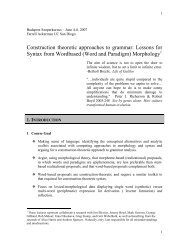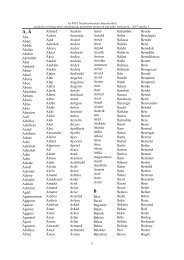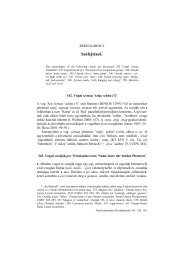Nyelvtudományi közlemények 91. kötet (1990)
Nyelvtudományi közlemények 91. kötet (1990)
Nyelvtudományi közlemények 91. kötet (1990)
Erfolgreiche ePaper selbst erstellen
Machen Sie aus Ihren PDF Publikationen ein blätterbares Flipbook mit unserer einzigartigen Google optimierten e-Paper Software.
60 ERIC P. HAMP<br />
In Ptolemy's list we find a place identified with ruins near "Soezny 55<br />
m. from Flexum" (Holder 540-1) Alt-0-Szöny. The text prints Bijerioi/<br />
'Brigetium,' and the following variants are recorded: BQL^OLÍTIOV (in MS<br />
X), Bgatyériov (FNS$^), Bgayairiov (C), Bgaiyatriov (ABDEGL<br />
SZAEÍ1), BgejaÍTiov (ceteri). If we regard C as perhaphs a lapse omitting<br />
an iota, these reduce to [Bregétion] beside [Brigétion]. In inscription<br />
Bregetio is reported, Brigetionem ceteri, while the itinerary, Not. Dign. and<br />
Ammian. testimony yields Bregetionem and Bregitionem. There is other evidence<br />
for e in the first syllable in some manuscript testimony (e. g. Victor<br />
Ep.), but without a complete textual criticism it would not profit us at<br />
present to rehearse these facts further in detail. This is because there are<br />
two considerations that might vitiate the Celtic significance of this variation<br />
in any case, as we shall see.<br />
We note two further facts in particular regarding the variants. The<br />
CIL attestation of the name shows us nearly exclusively the spelling Brig-.<br />
This is important in giving a strong indication of the local direct tradition.<br />
The further implication is that spellings with Breg- m a y indicate<br />
secondary actual phonetic lowering of this original Brig-. The second fact<br />
is that Socrates H. Eccl. attests for us Beg^iriuu. This form is important<br />
not only in showing the stem termination -CUJU (which is morphologically,<br />
if not phonologically distinctive and relevant), but also in carrying the vocalization<br />
Begy-. We shall see shortly that this vocalism may well not stem<br />
from a simple error, but may reflect an old truth independently motivated.<br />
Therefore the e of our variants in Breg- could conceivably have arisen by<br />
conflation with Berg.<br />
In this fashion we reach two irreducible possibilities for the first syllable:<br />
Brig- and Berg-. Both of these will be seen to belong to possible Celtic<br />
formations inherited from Indo-European. It has already been well recognized<br />
that Celtic attests reflexes of the Indo-European base *bhergh-; I have<br />
in fact recently (Hamp 1986) discussed the formations lying behind Celtic<br />
* brigantmos. As a matter of fact, this type of formation brings to mind the<br />
variant of our place-name which is found in the Peutinger Table, Brigajitio,<br />
and the further variant Bregentionem Victor Ep., which must somehow depend<br />
on it. Holder properly brands the Peutinger variant "falsch"; we must<br />
view the forms in -et- and -it- which we have passed in review as variants of<br />
a lectio difficilior, and thus regard the Peutinger -ant- as an intrusion from<br />
the widely documented stem brigant- (Holder 535-9). 5 We are therefore<br />
assured of Brig- or Berg- -f -et- or -it-.<br />
Besides Briantes (Indre), recorded in 1291, and Briangonnet (Alpes-Mar.), written in<br />
an inscription ordo Brig and in 997-1027 Brianzo, note especially Briangon (H.-Alpes),<br />
which Strabo had as Brigantion and the Vases apollinaires as Brigantium and the<br />
Peutinger Table itself knew as Brigantione.<br />
Nyelvtudományi Közlemények <strong>91.</strong> <strong>1990</strong>.


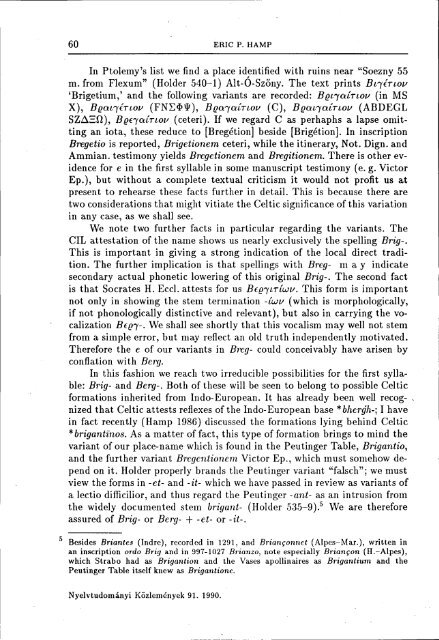

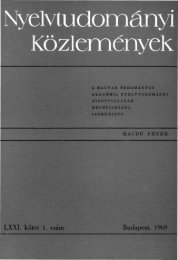

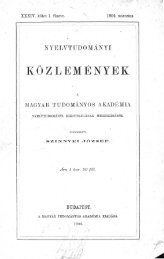
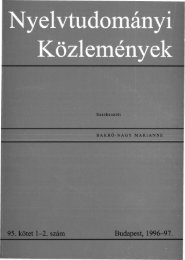
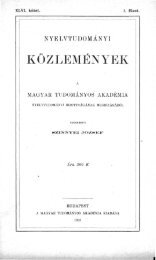
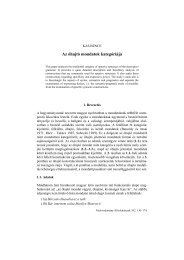
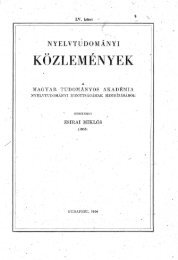
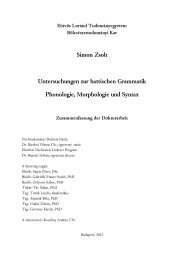
![Gósy Mária: A [p, t, k] mássalhangzók zöngekezdési ideje Bevezetés ...](https://img.yumpu.com/15682849/1/190x245/gosy-maria-a-p-t-k-massalhangzok-zongekezdesi-ideje-bevezetes-.jpg?quality=85)

